TOP LIST – The handheld console market in 2024 has expanded with exciting new options, offering gamers a variety of choices. While the Nintendo Switch remains a popular pick, competitors such as the ASUS ROG Ally X and the Steam Deck OLED have entered the fray. As the holiday season approaches, we’ve compiled a list of the seven best handheld consoles to help you pick the perfect gift for yourself or your loved ones.
The latest handheld consoles can run full-fledged console and PC games like Destiny 2 or Fortnite and provide access to a treasure trove of retro classics like Pokémon Red and Blue and Battletoads. Some even function as tablets. While the Nintendo Switch doesn’t excel in every category, it still dominates this segment thanks to its portability, long battery life, and a steady stream of exclusive games like Paper Mario: The Thousand-Year Door and a robust library of third-party titles. With detachable controllers, it easily transforms from a handheld to a home console with the help of a dock. Available since 2017, the Switch remains a staple.
Since then, Nintendo has made few updates beyond the OLED screen introduced in 2021. Its processor isn’t as powerful as what you’d find in other handhelds or even smartphones, but Nintendo’s well-designed games make up for it. It remains the third-best-selling gaming console of all time—not just among handhelds. Other handhelds, combined, hold only a fraction of the Switch’s market share.
This means there’s no definitive “best” choice here. If you’re looking for a well-crafted, fun handheld that works right out of the box and you don’t already own a Switch, you’ll likely find it worth buying (and you can read on to explore the differences between the available models). If you’re after the latest handheld consoles, I tested seven to find the best ones.
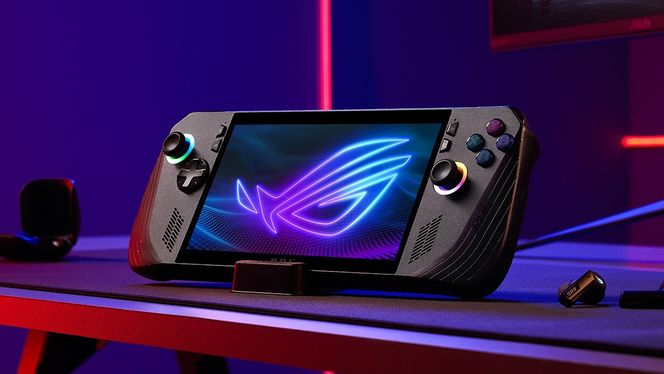

1. ASUS ROG Ally X
- Price: $699
- Platform: Windows
- Weight: 1.49 lbs (675 g)
- Screen Size and Resolution: 7-inch; 1920 x 1080
- Screen Type: LED
- Storage: 256 GB; microSD card slot
- Battery Life: 1–5 hours
- Ports: 2 x USB-C
The ASUS ROG Ally X is the only handheld on this list running a Windows operating system and boasts the best battery life among Windows-based handhelds I’ve tested—addressing a common complaint among users and reviewers. Playing Baldur’s Gate 3 on default settings, I managed nearly three hours of gameplay, compared to just two hours on the original Ally. This improvement is due to the Ally X’s 80 Wh battery, which doubles the capacity of its predecessor. Among all the tested consoles, this one has the best built-in sound quality: clear audio at maximum volume with easily discernible dialogue.
The ROG Ally X features slightly improved controls compared to the original Ally, offering a more comfortable grip than the Legion Go (though I’d recommend the latter if you want detachable controllers akin to the Nintendo Switch). The sides rest comfortably in your palms, and the buttons and joysticks are easily accessible without straining your hands. The buttons are responsive, and the joysticks move smoothly, though the lack of a trackpad—found on both the Steam Deck and Legion Go—limits precise movements and cursor control. While I wished the Ally X had detachable controllers, I appreciate ASUS keeping the handheld lightweight enough to prevent arm fatigue.
The Ally X’s display, identical to the previous model, is bright, sharp, and responsive, even during action-packed games. Its LED screen doesn’t deliver colors as vibrant as the Steam Deck OLED, but games still look great. Titles like Grand Theft Auto V and Baldur’s Gate 3 run smoothly without overheating the console.
Unlike the original Ally, which had only one USB-C port and external GPU support limited to ASUS products, the Ally X includes two ports and supports third-party external GPUs. The extra port can connect to a monitor or TV and a docking station to attach peripherals like a wired keyboard or mouse.
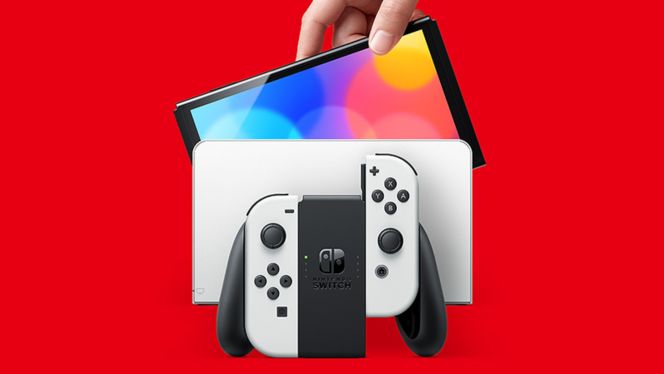

2. Nintendo Switch OLED
- Price: $349
- Platform: Nintendo
- Weight: 0.71 lbs (322 g)
- Screen Size and Resolution: 7-inch; 1280 x 720
- Screen Type: OLED
- Storage: 64 GB
- Battery Life: 4.5–9 hours
- Ports: 1 x USB-C
I’ve been using the Nintendo Switch since 2017, playing everywhere from San Francisco’s BART trains to cramped airplane seats to my couch. Weighing less than a pound, it’s barely noticeable in my bag and easy to pull out with one hand. While I wish it had more AAA titles like Baldur’s Gate, the Switch still boasts an extensive (and fun) library for those not tied to the latest PC games.
Other than the 2021 OLED screen update, Nintendo hasn’t significantly altered the original model since its debut. This speaks to the strength of its design. The display—especially on the newer OLED model—still looks excellent, even if it’s not as sophisticated as other consoles on this list. That’s because the games available on the Switch are specifically designed for it.
The Switch is the only way to play Nintendo-exclusive titles like The Legend of Zelda: Tears of the Kingdom and access old console classics like SNES games through a Nintendo Switch Online subscription. While you can emulate these on other consoles, the Switch is the only official way to enjoy retro Nintendo classics. You won’t find games like Elden Ring here, but indie titles like Celeste and Hades are available and run as well as on any other platform. With over 10,000 titles in the Nintendo Store, the library isn’t as vast as Steam’s but still offers plenty of fantastic games.
The Joy-Con controllers are lightweight and easy to grip, snapping into a controller shape for a more traditional hold. I prefer the Nintendo Switch Pro controller when the Switch is docked, but the Joy-Con controllers work just fine.
I appreciate the included stand for tabletop play, though its cheap plastic and fixed angle are drawbacks. Still, it’s better than having no option at all.
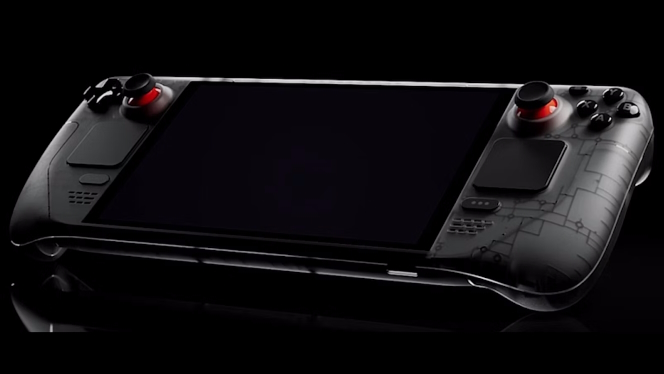

-
Steam Deck OLED
- Price: $549
- Platform: Custom Linux
- Weight: 1.47 lbs (667 g)
- Screen Size and Resolution: 7-inch; 1280 x 800
- Screen Type: OLED
- Storage: 512 GB
- Battery Life: 2–5 hours
- Ports: 1 x USB-C
Valve’s Steam Deck isn’t as versatile as the ASUS Ally X because running games outside the Steam store requires modifications. However, it’s the closest thing to a handheld PC gaming console as refined as the Nintendo Switch. With its custom interface and direct integration with the Steam store, the Deck offers a seamless, user-friendly experience.
The Steam Deck’s operating system is designed to launch directly into your game library, like a traditional console. You can easily navigate the store and purchase new games. The Steam platform conveniently indicates whether a game is compatible with the Deck, sparing you any unpleasant surprises. The interface is the most polished and intuitive I’ve seen on a handheld console, and if you’re familiar with Steam’s desktop software, you’ll quickly grasp how the Deck works.
Similar to the ASUS Ally X, the Deck provides extensive performance customization options, though its interface is cleaner and features more accessible. For instance, you can set separate refresh rate caps for each game instead of adjusting overall settings each time. Games like The Elder Scrolls: Skyrim and Baldur’s Gate 3 ran well on the Deck, but the battery typically lasted just two hours. Less demanding games, like Stardew Valley or Terraria, stretched the battery life to about five hours.
The Deck’s controls are comfortable to hold, with buttons neither too soft nor too stiff. The device features joysticks and trackpads on both sides and two quick-access buttons. The OLED display delivers more vibrant colors than the ASUS Ally X’s LED screen, though its lower resolution shows fewer details.
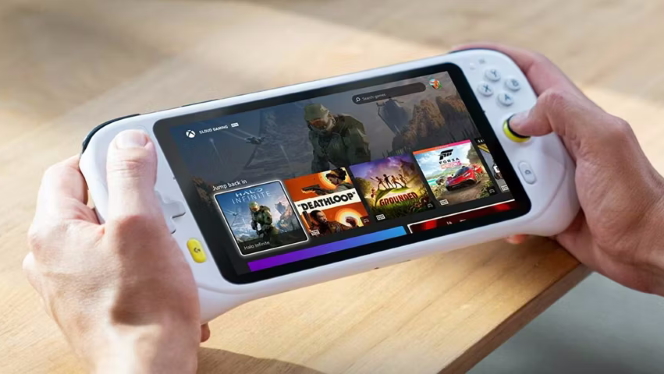

4. Logitech G Cloud
- Price: $349
- Platform: Android
- Weight: 1.02 lbs (463 g)
- Screen Size and Resolution: 7-inch; 1920 x 1080
- Screen Type: OLED
- Storage: 64 GB
- Battery Life: 10 hours
- Ports: 1 x USB-C
Cloud gaming has advanced significantly, allowing you to stream AAA titles like Fallout 4 from a browser with a good internet connection. While the Logitech G Cloud lacks the power of the Ally X or the Steam Deck, it doesn’t need it since all games run on servers. Instead, the G Cloud runs a custom Android version, enabling you to log into cloud gaming platforms like Xbox Game Pass or Nvidia Cloud Gaming.
This means you’ll need to stay online to play games typically requiring more powerful consoles. However, since it runs Android, you can also install offline games from the Google Play Store, such as Stardew Valley or Hades (through a Netflix subscription), and insert an SD card to store more content than its built-in 64 GB allows.
You won’t see as much detail on the G Cloud’s 1080p display as on the Ally X, but its resolution is higher than any other console I tested. Even while gaming over the internet, the screen delivered great visuals, provided the connection remained stable.
One major advantage of cloud gaming is the ability to start a game immediately without waiting for large downloads. Of course, this requires an internet connection, but launching a game without waiting for a 60 GB file to download is a relief.
The G Cloud’s battery life far outlasts any other non-Switch console I tested, lasting up to ten hours.
While detachable controllers aren’t a necessity for a handheld console, the G Cloud could benefit from having them. Since it runs Android, it can double as a tablet for apps like Netflix or Kindle, though its fixed controls make it cumbersome for anything besides gaming.
If you’re looking for a large-screen device for easy access to cloud gaming, the G Cloud is a clear choice. The Ally X also supports these services but is pricier and has a shorter battery life for the same tasks. The G Cloud also works well with emulators from the Google Play Store and, being lighter than the Steam Deck and Ally X, serves as a better emulation machine.
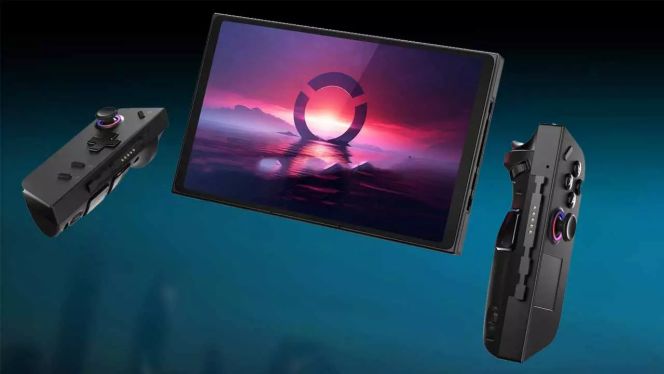

5. Lenovo Legion Go
- Price: $699
- Platform: Windows 11
- Weight: 1.88 lbs (854 g)
- Screen Size and Resolution: 8.8-inch; 2560 x 1600
- Screen Type: QHD+ IPS LED
- Storage: 512 GB (expandable via microSD)
- Battery Life: 3–6 hours
- Ports: 2 x USB-C, 1 x 3.5 mm jack
The Lenovo Legion Go is one of the newest contenders in the handheld market, designed with gamers in mind. Its 8.8-inch QHD+ screen stands out from other handhelds, offering vivid colors and wide viewing angles thanks to IPS panel technology. Running on Windows 11, it delivers a full PC gaming experience in a portable form.
The device is powered by an AMD Ryzen Z1 Extreme processor, providing excellent performance for running the latest AAA titles. Its 512 GB SSD provides ample storage for large games, while the expandable microSD slot offers additional flexibility. The Legion Go’s ergonomic design and detachable controllers, similar to the Nintendo Switch, allow for both handheld and tabletop use.
Its biggest strengths, aside from the display, lie in its customization options. Gamers can adjust various graphics and performance settings directly on the console to optimize it for specific games. The touchscreen adds convenience, particularly for Windows-based apps.
Battery life ranges from 3 to 6 hours, depending on game intensity. Lower graphics settings and less demanding games can extend the runtime. The Legion Go includes two USB-C ports for fast charging, connecting peripherals, or using monitors, making it a viable desktop replacement.
Although heavier than other handhelds, its ergonomic grip and weight distribution prevent discomfort during long gaming sessions. It supports Wi-Fi 6E technology, ensuring fast, stable internet for cloud gaming or online multiplayer modes.
The Lenovo Legion Go is ideal for those seeking uncompromising PC gaming in a portable package, with its flexibility and premium display enhancing the experience further.
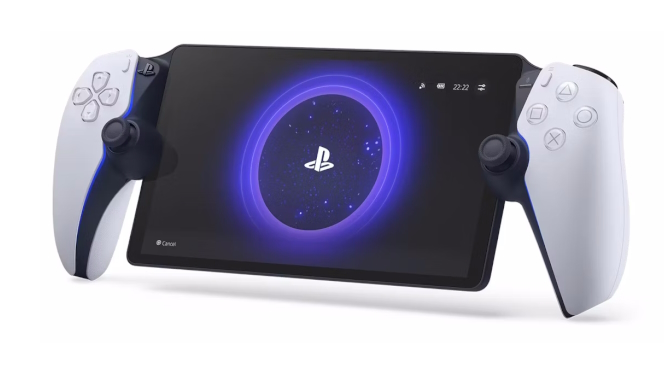

6. PlayStation Portal
- Price: $199
- Platform: PlayStation Remote Play / PS Plus Premium
- Weight: 1.35 lbs (614 g)
- Screen Size and Resolution: 8-inch; 1920 x 1080
- Screen Type: LCD
- Storage: None (streaming-only)
- Battery Life: 5–7 hours
- Ports: 1 x USB-C, 1 x 3.5 mm jack
The PlayStation Portal is Sony’s streaming-based handheld console, initially designed exclusively for remote access to the PlayStation 5. However, with recent updates, the Portal now supports direct streaming of over 100 games in the PS Plus Premium library for subscribers, eliminating the need for a PS5 to use the device. This marks a significant expansion of its functionality, offering a “PS5-free” PlayStation experience for those who prefer cloud-based gaming.
The PS Portal delivers an authentic PlayStation experience with the DualSense controller’s features built directly into the console. Its 8-inch, 1080p LCD screen provides sharp, clear visuals ideal for enjoying Sony’s visually impressive games. However, the device heavily relies on a stable network connection: both PS5 Remote Play and PS Plus Premium streaming require strong Wi-Fi for smooth performance.
Tested over Wi-Fi and unlimited mobile data, the Portal performed well on Wi-Fi, with crisp visuals and minimal latency for both Remote Play and PS Plus Premium games. On mobile data, however, the experience degraded significantly, with blurry visuals and laggy gameplay. This limitation isn’t exclusive to the Portal but affects all streaming-based handhelds—mobility is questionable without a solid Wi-Fi connection.
The minimalistic design includes the DualSense controller’s tactile feedback and adaptive triggers, delivering a uniquely PlayStation feel. The console lacks internal storage, focusing solely on streaming, whether through PS5 Remote Play or directly from the PS Plus Premium library.
Battery life ranges between 5 and 7 hours, sufficient for extended gaming sessions. The USB-C port supports fast charging, while the 3.5 mm jack allows for wired headphone use. Its lightweight, ergonomic design ensures comfort during long gaming sessions.
The PS Portal is a great choice for PlayStation enthusiasts who want to play on the go using PS5 or PS Plus Premium services. However, its reliance on Wi-Fi limits its true portability. For those primarily gaming at home on a stable connection, the Portal offers a unique and enjoyable experience.
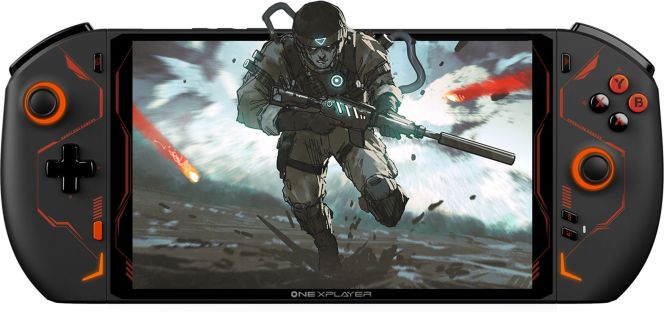

7. OneXPlayer 2
- Price: $1,199
- Platform: Windows 11
- Weight: 1.87 lbs (850 g)
- Screen Size and Resolution: 8.4-inch; 2560 x 1600
- Screen Type: IPS Touchscreen
- Storage: 2 TB SSD (expandable via microSD)
- Battery Life: 2–5 hours
- Ports: 2 x USB-C (one USB 4.0), 1 x USB-A, 1 x 3.5 mm jack, 1 x microSD
The OneXPlayer 2 is one of the most powerful handheld gaming consoles on the market, delivering a true PC gaming experience in a portable form. Its 8.4-inch IPS touchscreen with a resolution of 2560 x 1600 offers stunning detail and vivid colors, making it ideal for both visually demanding AAA games and creative work. Running Windows 11, it supports nearly any PC game or application seamlessly.
At its core is the AMD Ryzen 7 6800U processor, boasting 8 cores and 16 threads with a maximum clock speed of 4.7 GHz. The integrated Radeon 680M GPU, based on the RDNA 2 architecture, delivers 12-core graphical performance, sufficient for running the latest games at high settings. The console comes with a 1 TB SSD as standard, offering fast and ample storage, expandable via microSD.
A standout feature is its detachable controllers, similar to the Nintendo Switch’s Joy-Cons. These controllers enhance handheld play but can also be docked into a more traditional controller form, ideal for tabletop or desktop use. They provide precise and comfortable handling but require a separate adapter to operate when detached, as they lack their own batteries.
The OneXPlayer 2 excels as a handheld console. While it isn’t built around streaming, its robust Wi-Fi 6E support ensures fast internet for multiplayer games and cloud services. Battery life ranges from 2 to 5 hours, depending on the game and settings used. The USB-C port supports 100 W fast charging, allowing quick recharges between sessions.
The 8.4-inch IPS display offers sharp visuals and impressive color accuracy, perfect for visually rich games. Despite its heavier weight, the ergonomic design ensures comfort during extended play sessions. Its premium build quality and materials provide a high-end feel.
The OneXPlayer 2 is a powerhouse in handheld gaming, ideal for serious PC gamers. While its price is on the higher end, its performance, versatility, and premium display justify the cost for those seeking an uncompromising gaming experience.
-Gergely Herpai “BadSector”-